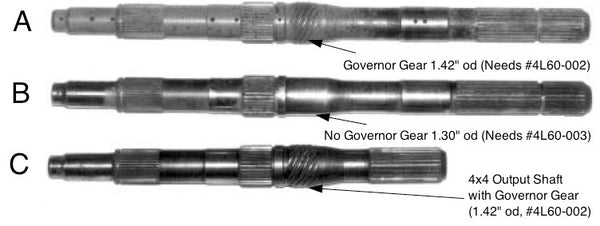Stealth Conversions
Reluctor Rings 4L60-002 and 4L60-003
Reluctor Rings 4L60-002 and 4L60-003
Couldn't load pickup availability
WHY YOU NEED ONE. Without the correct Vehicle Speed Sensor (VSS) and Reluctor Ring, the fuel-injected TPI or TBI engine with electronic transmission that you install in your swap will run poorly and will not pass a smog test. Download our free book excerpt on Vehicle Speed Sensors for the big VSS picture.
How do Reluctor Rings fit in? Each of the 40 nubs of either size of our 4L60-E reluctor rings emits a magnetic pulse picked up by the nearby speed sensor (creating more pulses per second as the shaft the ring is on rotates faster). The rotational speed indicated by those pulses allows the Engine Control Module (ECM) to control shift points, idle speed, air/fuel ratio, anti-lock brakes, and other stuff.
WHICH SIZE RELUCTOR RING DO YOU NEED? Take a look at Figure 1 below.
FIGURE 1

Some output shafts (from cars with R700 non-electronic transmissions and most aftermarket transfer case adaptor and output shafts) include the governor gear shown on shafts A and C above. The governor gear drives the mechanical transmission governor that predates VSSs. Speed changes cause the movement of weights from centrifugal force in the governor that instigate gear shifts via a cable.
Regardless of whether you have the long output shaft from a 2WD application or the truncated length of the 4x4 application shown in shaft C above, if the governor gear is present, the outer diameter is 1.42 and you need the 4L60-002 Reluctor Ring that fits over it. Without the governor gear, the outer diameter is 1.30” and you need the 4L60-003 Reluctor Ring.
Figure 2
Installation. The reluctor ring must be installed in this governor area because the Engine Control Module (ECM) would get an erroneous speed signal when the transfer case is in low range if the reluctor ring was located on the output shaft.
Installing the Reluctor Ring in close proximity to the VSS requires drilling and tapping a 3/4”-16 UNF thread hole into the transmission case as shown in Figure 2 above.
The wall thickness of the case is 5/16” in the areas a VSS screws into, which gives five full threads of engagement. When installing the sensor, coat the threads with epoxy, then screw the sensor into the case until it just touches the reluctor ring, then back it off 1/2 turn. This gives a .030” gap, which is ideal. Epoxy putty should be built up around the sensor on the outside of the case to hold the sensor securely in place.
Many people fear drilling and tapping a hole into the transmission case. But the case is aluminum, and it is an easy job to drill and tap. The positioning of the hole is not that critical, and the drilling can be done with a hand-held electric drill. To keep aluminum chips from getting into the transmission, put a piece of tape over the oil return hole (about 1/2” diameter), and put a piece of tape over the oil spray hole. After drilling and tapping the hole, wipe the area clean with a paper towel and remove the two pieces of tape.
The speed sensor (we have an OEM version of GM part #15547452) can be mounted on the driver’s side or the passenger’s side (the sensor is shown on both sides in Figure 2).
On 4x4 applications, the shift linkage to the transfer case may interfere with the sensor if it is installed on the driver’s side, so mounting the sensor on the passenger’s side is the obvious solution.
Rather Not Drill? Need to Handle a Cable-Driven Speedometer? You can eliminate the need to drill a hole in the transmission case for 2WD applications, using our part #4L60-005. The kit takes care of feeding both the VSS and a cable-driven speedometer. A collar clamp holds the speedometer drive gear onto the full-size 2WD output shaft while properly positioning a reluctor ring forward of its original position in alignment with the speed sensor mounting on a modified tailhousing. For details, download our free book excerpt on Vehicle Speed Sensors.
Share


